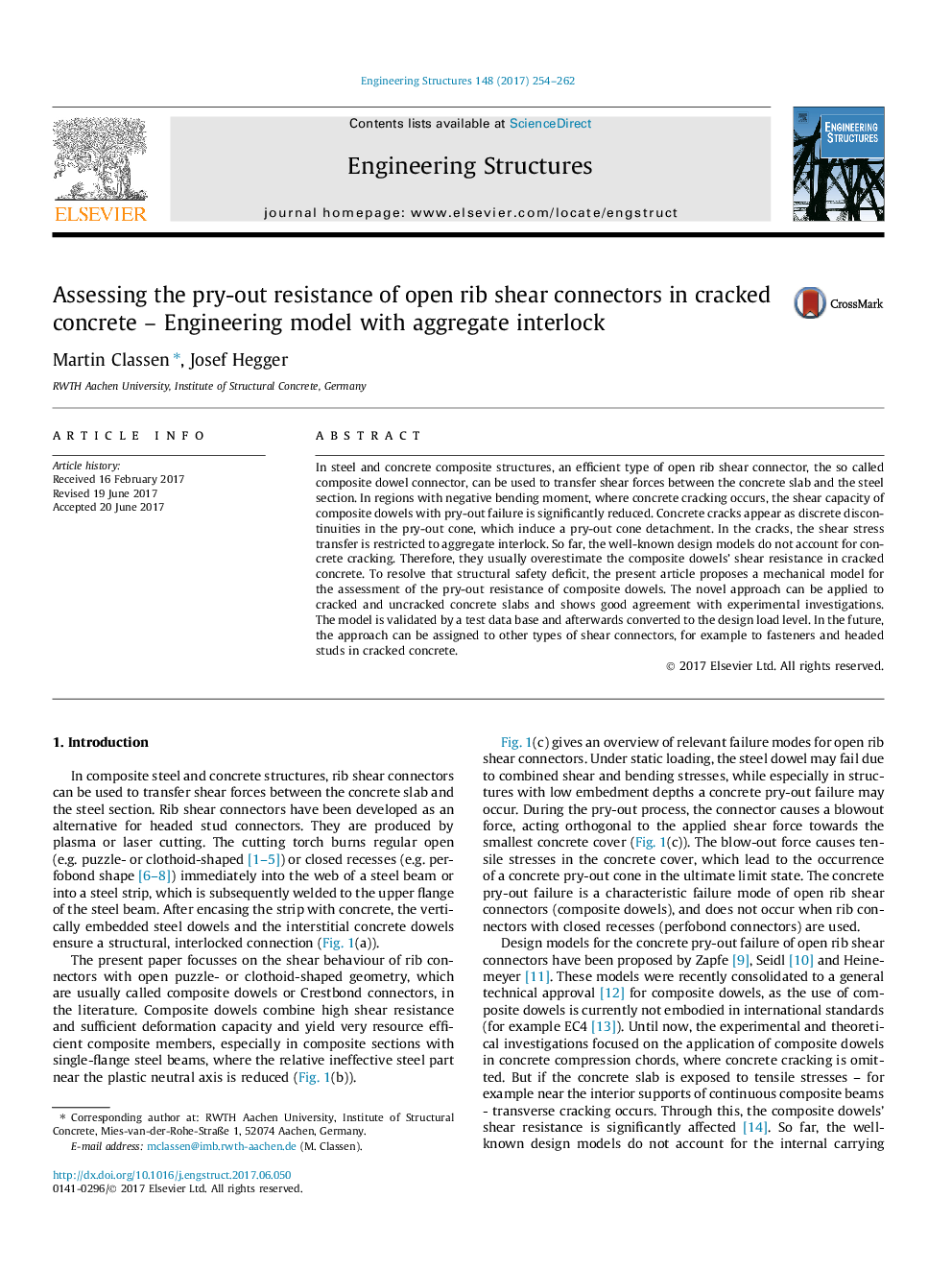| کد مقاله | کد نشریه | سال انتشار | مقاله انگلیسی | نسخه تمام متن |
|---|---|---|---|---|
| 4919997 | 1429079 | 2017 | 9 صفحه PDF | دانلود رایگان |
عنوان انگلیسی مقاله ISI
Assessing the pry-out resistance of open rib shear connectors in cracked concrete - Engineering model with aggregate interlock
ترجمه فارسی عنوان
ارزیابی مقاومت بیرونی اتصالات برشی باز در بتن ترک خورده - مدل مهندسی با همدستی کامل
دانلود مقاله + سفارش ترجمه
دانلود مقاله ISI انگلیسی
رایگان برای ایرانیان
ترجمه چکیده
در ساختارهای کامپوزیتی فولادی و بتنی، یک نوع کارآمد از اتصالات برشی برشی باز، به اصطلاح اتصال دهنده اتصال کامپوزیت، می تواند برای انتقال نیروهای برشی بین اسلب بتونی و بخش فولاد استفاده شود. در مناطقی که لحظه خمشی منفی دارند، که در آن ترک خوردگی بتن رخ می دهد، ظرفیت برشی ضول کامپوزیت با شکست ناپایدار به طور قابل توجهی کاهش می یابد. ترک های بتنی به عنوان مخلوط گسسته در مخروط بیرون زدگی ظاهر می شوند که منجر به جدا شدن مخروطی می شود. در ترک ها، انتقال تنش برشی محدود به اتصال متقابل است. تا کنون، مدل های شناخته شده طراحی برای ترک خوردگی بتن حساب نمی شود. بنابراین، آنها معمولا مقاومت برشی کامپوزیت کامپوزیت در بتن کرکی را بیش از حد ارزیابی می کنند. برای حل این کمبود ایمنی ساختاری، مقاله حاضر، یک مدل مکانیکی برای ارزیابی مقاومت به انقباض ضایعات کامپوزیتی ارائه می دهد. رویکرد جدید را می توان به اسکلت های ترک خورده و نشتی بتن اعمال کرد و توافق خوبی با تحقیقات تجربی را نشان می دهد. مدل با استفاده از یک پایگاه داده آزمایشی معتبر و پس از آن تبدیل به سطح بار طراحی شده است. در آینده، این رویکرد را می توان به انواع دیگر اتصالات برشی اختصاص داد، به عنوان مثال به اتصال دهنده ها و ستون های سر در بتن ترک خورده.
موضوعات مرتبط
مهندسی و علوم پایه
علوم زمین و سیارات
مهندسی ژئوتکنیک و زمین شناسی مهندسی
چکیده انگلیسی
In steel and concrete composite structures, an efficient type of open rib shear connector, the so called composite dowel connector, can be used to transfer shear forces between the concrete slab and the steel section. In regions with negative bending moment, where concrete cracking occurs, the shear capacity of composite dowels with pry-out failure is significantly reduced. Concrete cracks appear as discrete discontinuities in the pry-out cone, which induce a pry-out cone detachment. In the cracks, the shear stress transfer is restricted to aggregate interlock. So far, the well-known design models do not account for concrete cracking. Therefore, they usually overestimate the composite dowels' shear resistance in cracked concrete. To resolve that structural safety deficit, the present article proposes a mechanical model for the assessment of the pry-out resistance of composite dowels. The novel approach can be applied to cracked and uncracked concrete slabs and shows good agreement with experimental investigations. The model is validated by a test data base and afterwards converted to the design load level. In the future, the approach can be assigned to other types of shear connectors, for example to fasteners and headed studs in cracked concrete.
ناشر
Database: Elsevier - ScienceDirect (ساینس دایرکت)
Journal: Engineering Structures - Volume 148, 1 October 2017, Pages 254-262
Journal: Engineering Structures - Volume 148, 1 October 2017, Pages 254-262
نویسندگان
Martin Classen, Josef Hegger,
